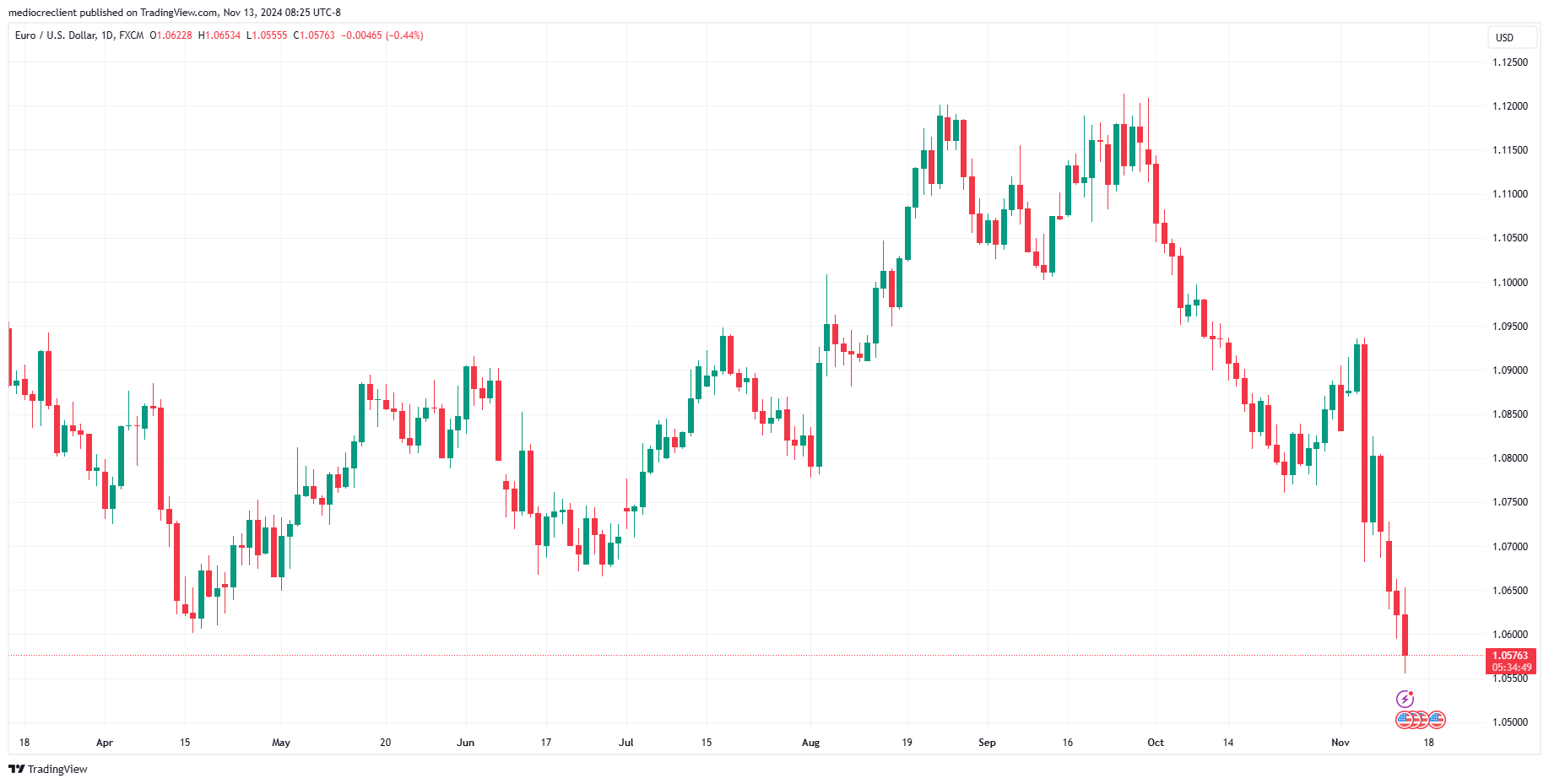- EUR/USD fell below 1.0600 on Wednesday, heading towards 1.0550.
- A brief recovery following the US CPI inflation data is unlikely to sustain.
- The Euro is set to close in the red against the Dollar for the fourth consecutive day.
EUR/USD continued to retreat on Wednesday, falling towards 1.0550 and finding only a slight rebound from 54-week lows after US Consumer Price Index (CPI) inflation for October was released near median market forecasts. The Euro continues to lose followers as market participants struggle to find reasons to bid for Fiber, leaving EUR/USD at the mercy of US Dollar flows in the broader market.
US CPI inflation for October was released largely as expected on Wednesday, however the final figures failed to make progress towards cooling targets, and key annual measures accelerated year-on-year. The US CPI rose 0.2% month-on-month in October, in line with the previous month’s inflation figure, while the ‘supercore’ CPI for the year ending in October rose 4.37% year-on-year in compared to 4.26% in the previous period.
The US Dollar eased slightly after the CPI, giving Fiber a chance to regain its position from one-year lows, however, momentum remains weak as global markets focus heavily on US jobs numbers. .US to trigger further rate cuts by the Federal Reserve (Fed).
EUR/USD Price Forecast
With the Euro testing 54-week lows against the Dollar, the pressure is on bidders to find a bottom and push off of it before things deteriorate to the point that EUR/USD retreats below the technical floor set near 1.0500. It’s been a sharp turn in Fiber offerings this year: just seven weeks ago, the Euro had hit a more than one-year high against the US Dollar, just below 1.1300.
EUR/USD Daily Chart
The Euro FAQs
The Euro is the currency of the 19 countries of the European Union that belong to the eurozone. It is the second most traded currency in the world, behind the US dollar. In 2022, it accounted for 31% of all foreign exchange transactions, with an average daily turnover of more than $2.2 trillion per day. EUR/USD is the most traded currency pair in the world, accounting for an estimated 30% of all transactions, followed by EUR/JPY (4%), EUR/GBP (3%) and EUR/AUD (2 %).
The European Central Bank (ECB), headquartered in Frankfurt, Germany, is the reserve bank of the eurozone. The ECB sets interest rates and manages monetary policy. The ECB’s primary mandate is to maintain price stability, which means controlling inflation or stimulating growth. Its main tool is the increase or decrease in interest rates. Relatively high interest rates (or the expectation of higher rates) tend to benefit the euro and vice versa. The Governing Council of the ECB makes decisions on monetary policy at meetings held eight times a year. Decisions are made by the directors of the Eurozone’s national banks and six permanent members, including ECB President Christine Lagarde.
Eurozone inflation data, measured by the Harmonized Index of Consumer Prices (HICP), are an important econometric indicator for the euro. If inflation rises more than expected, especially if it exceeds the ECB’s 2% target, it forces the ECB to raise interest rates to bring it back under control. Relatively high interest rates compared to their counterparts tend to benefit the euro, making the region more attractive as a place for global investors to park their money.
The published data measures the health of the economy and may have an impact on the euro. Indicators such as GDP, manufacturing and services PMIs, employment and consumer confidence surveys can influence the direction of the single currency. A strong economy is good for the Euro. Not only does it attract more foreign investment, but it may encourage the ECB to raise interest rates, which will directly strengthen the euro. Otherwise, if economic data is weak, the Euro is likely to fall. Economic data for the four largest eurozone economies (Germany, France, Italy and Spain) are especially significant, as they represent 75% of the eurozone economy.
Another important data that is published about the Euro is the trade balance. This indicator measures the difference between what a country earns from its exports and what it spends on imports during a given period. If a country produces highly in-demand export products, its currency will gain value simply from the additional demand created by foreign buyers seeking to purchase those goods. Therefore, a positive net trade balance strengthens a currency and vice versa in the case of a negative balance.
Source: Fx Street
I am Joshua Winder, a senior-level journalist and editor at World Stock Market. I specialize in covering news related to the stock market and economic trends. With more than 8 years of experience in this field, I have become an expert in financial reporting.







